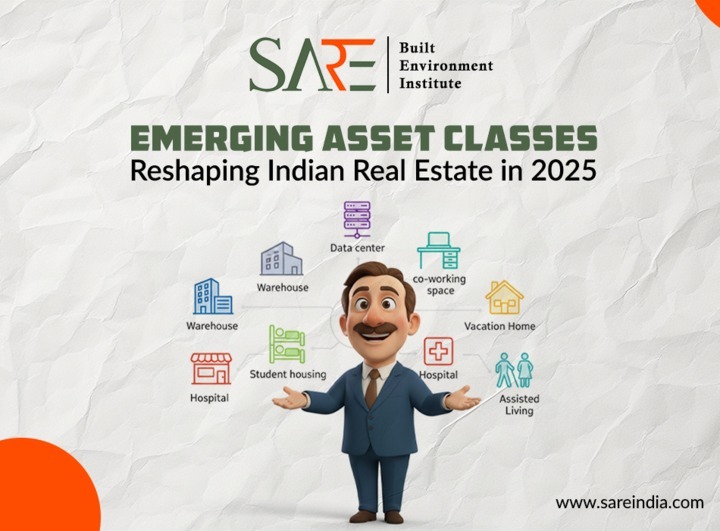Owning a luxury office, co-working space, or a holiday home was a dream for many, but now small investors in India can own properties without spending crores. Fractional ownership, InvITs (Infrastructure Investment Trusts), and REITs (Real Estate Investment Trusts) are positively changing the current situation of real estate investment in India.
Understanding how these models lower barriers and democratize access to premium properties is a future-ready plan for professionals, aspiring investors and students in the real estate sector. These models increase transparency and democracy in real estate investing while also lowering the entry barrier. Let’s deep dive to understand each concept and how it will impact the present and future of Real Estate Investment.
What Is Fractional Ownership?
As the name suggests, fractional ownership gives a part or fraction of ownership of an asset to investors. Each asset is divided into multiple shares, enabling multiple investors to participate without investing crores.
- As per the market research, fractional real estate investments usually begin around ₹10-20 lakhs in India.
- In this model, Grade-A office spaces, warehouses, retail outlets, and even vacation homes are included.
- Ownership is structured through LLPs or SPVs (Special Purpose Vehicles) ensuring profit distribution, management, and smoother exits.
This model makes institutional-grade real estate accessible to small retail investors also who earlier could not participate in such opportunities due to higher investments.
What Is Fractional Ownership?
As the name suggests, fractional ownership gives a part or fraction of ownership of an asset to investors. Each asset is divided into multiple shares, enabling multiple investors to participate without investing crores.
- As per the market research, fractional real estate investments usually begin around ₹10-20 lakhs in India.
- In this model, Grade-A office spaces, warehouses, retail outlets, and even vacation homes are included.
- Ownership is structured through LLPs or SPVs (Special Purpose Vehicles) ensuring profit distribution, management, and smoother exits.
This model makes institutional-grade real estate accessible to small retail investors also who earlier could not participate in such opportunities due to higher investments.
What Is a REIT and SM-REIT?
- A REIT (Real Estate Investment Trust) is something like a mutual fund for the real estate industry. Investors pool their money in the operational trusts, and the trust invests it to buy, operate, or finance income-generating properties.
- Some of the prominent listed REITs include Embassy Office Parks REIT, Mindspace Business Parks REIT, Brookfield REIT, and Blackstone REIT.
- One of the key advantages of REITs is the low entry point as investors can begin with just ₹10,000–₹15,000, making REITs accessible to beginners and small investors alike.
- SEBI regulations instruct these trusts to share at least 90% of their net income to investors on a regular basis, ensuring stable returns.
Understanding SM REITs in India
In 2024, SEBI also introduced SM-REITs (Small and Medium REITs) models for smaller investors or beginners who want to invest into fractional ownership in a regulated structure. REITs require a minimum asset size of ₹500 crore while SM-REITs are designed to provide smaller properties including both commercial and residential properties having an asset size between ₹50 crore and ₹500 crore.
This flexibility allows more investors to participate in professionally managed property investments opportunities. It has changed the previous investment situation as small investors with lower funds are now also able to participate in the game to make profits through REIs.
What is an InvIT?
An Infrastructure Investment Trust (InvIT) is a pooled investment vehicle, similar to REIT, but only allows investors to invest their money in income-generating infrastructure projects such as highways, electricity lines, and telecom towers. These investment vehicles play a crucial role in expanding India’s real estate and infrastructure sector, aiming to mirror the scale of the US, where REITs hold a market cap of $1.37 trillion and manage assets worth $4.5 trillion.
An InvIT is built on four main roles:
- Sponsor, who establishes the trust and provides the initial assets
- Trustee, who ensures that the interests of all unitholders are protected.
- The investment manager, who takes all the strategic decisions regarding the acquisition and management of assets
- Project manager handles the daily operations of the infrastructure projects
Why are REITs the Better Alternative Investment?
REITs are transforming the Indian real estate market by making property investment more accessible and democratic. Here’s why they stand out for investors:
1. Lower Entry Barriers
- REITs offer a lesser minimum amount for investment, making them ideal for beginners or small investors.
- Investors can own property without direct property purchases.
- Fractional ownership platforms are now also moving under the SM-REIT framework, increasing credibility and accessibility.
2. Attractive Returns
- Fractional real estate investments typically yield 7–8% annually.
- REITs provide stable returns through rental income from professionally managed assets making it better than mutual funds.
- Regulations mandate REITs to share at least 90% of their net income with investors which ensures stable profit along with potential capital appreciation.
3. Transparency and Regulation
- REITs are SEBI-regulated, providing investors with trust, accountability, and professional governance.
4. Professional Management
- REITs remove the hassles of property management, as experienced managers handle operations.
- Investors benefit from real estate exposure without dealing with tenants, maintenance, or legal matters.
Difference Between Fractional Ownership and REITs
As both fractional ownership and REITs share the same goal to democratize real estate investments and make it more affordable for Indian investors, there are some important and clear distinctions between them. Here are some listed:| Feature | Fractional Ownership | REITs |
|---|---|---|
| Investment Size | ₹10 lakh onwards | Starts with ₹10,000–₹15,000 |
| Control | Investors know the specific property they own | Ownership is in a diversified portfolio |
| Liquidity | Lower, depends on exit platform | Higher, traded on stock exchanges |
| Regulation | Emerging (SM-REITs introduced) | Fully SEBI-regulated |
| Returns | Potentially higher, riskier returns | Stable dividends and market-linked growth |
| Income Source | Rental income + capital appreciation | Rental income + dividends |
| Investor Control | Direct ownership control of property | No say in specific property choice |
| Market Size (India) | ~$600 million | ₹1.63 lakh crore (~$19 billion) |
| Capital Appreciation | High | Low |
The Future of Real Estate Investments in India
The growing trend of these prominent real estate investments models in India encourages more professionals, students, and retail investors to participate in real estate markets with smaller amounts, greater transparency, and reduced risk without limiting ownership to rich individuals or big institutions.
- Indian REITs currently manage about ₹1.63 lakh crore (~$19 billion), a fraction of the US trillion-dollar market. With the rise of SM-REITs, InvITs, and private structures, India’s real estate investment landscape is set to become more dynamic and globally competitive.
- In India, the fractional ownership market is estimated to grow over valued at over $5 billion by 2030 from the current value of $500-$600 million.
- Holiday homes and luxury second homes are becoming a hot trend in fractional real estate investment.
- Institutional-grade office spaces remain the most preferred asset class.













0 Comments